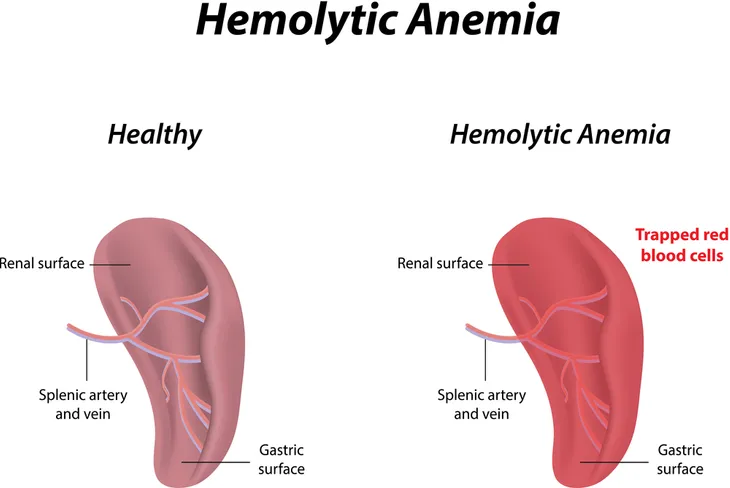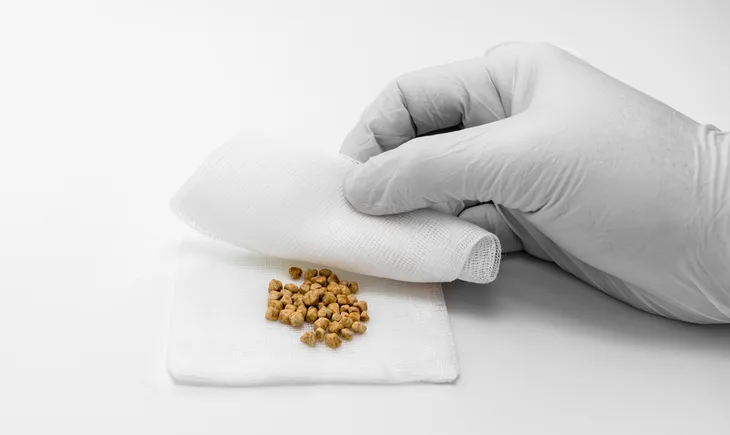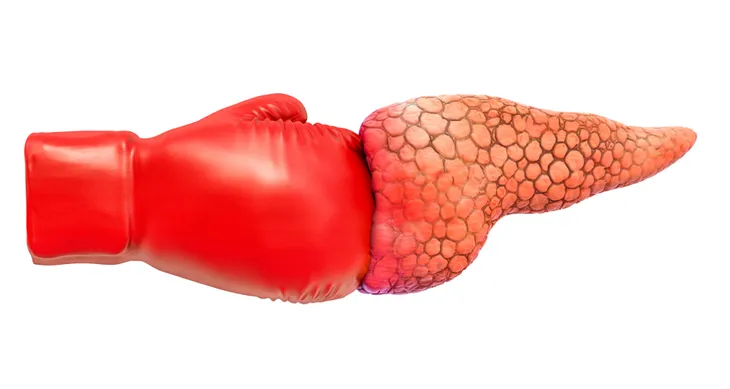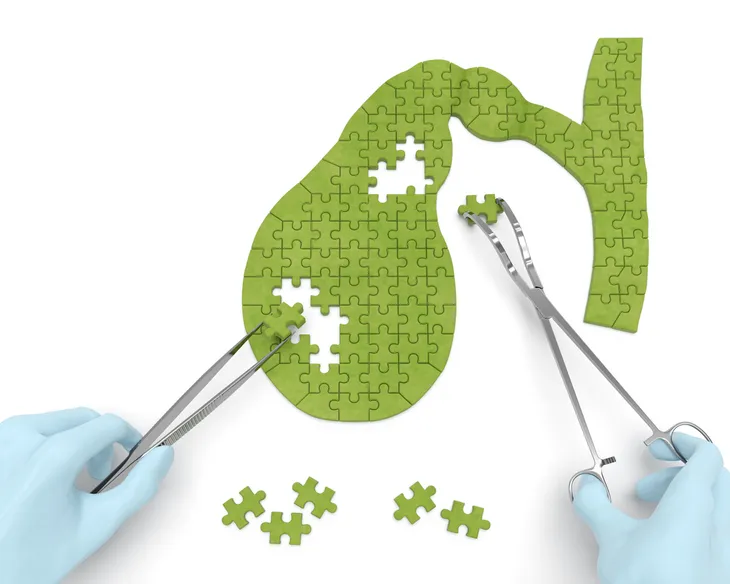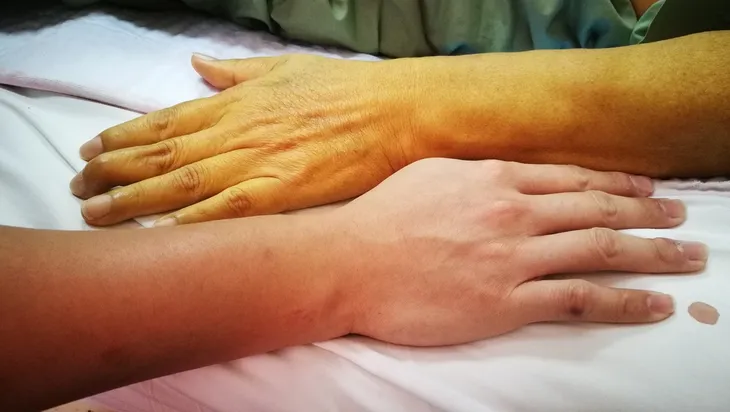Jaundice is a yellowish discoloration of the skin, sclera (whites of the eyes), and mucous membranes by bilirubin. The word “jaundice” is derived from the French word jaune, which means yellow. Bilirubin is a yellow-orange pigment found in bile, a fluid made by the liver. Bilirubin is produced when the liver breaks down old red blood cells. Bilirubin circulates in the blood in two forms—indirect (or unconjugated) and direct (or conjugated). Jaundice usually occurs when blood levels of bilirubin reach greater than 2.5 to 3-mg/dL. Jaundice in adults may be caused by a variety of either harmless or life-threatening disorders.
Ten causes of jaundice in adults are…
1. Hemolytic Anemia
Hemolytic anemia is a condition in which red blood cells are destroyed and removed from the bloodstream before their normal lifespan is concluded. The lifespan of a red blood cell is approximately 120-days. The term “anemia” usually refers to decreased numbers of red blood cells. It may also refer to low levels of hemoglobin, a protein allowing red blood cells to carry oxygen. Hemolytic anemia is characterized by increased levels of indirect bilirubin in the bloodstream.
The causes of hemolytic anemia vary and may be inherited or acquired. Inherited causes of hemolytic anemia include hereditary disorders such as glucose-6-phosphate dehydrogenase (G6PD) deficiency (the most common enzyme deficiency in humans), hereditary spherocytosis (a defect in red blood cell membrane proteins), and sickle cell disease (abnormal hemoglobin in red blood cells). Acquired hemolytic anemia may be caused by drugs such as acetaminophen, penicillin, and oral contraceptives; infections such as malaria; and autoimmune disorders such as lupus.
2. Hepatitis
Hepatitis refers to inflammation of the liver. Common causes of hepatitis include viral infections (hepatitis A, B, C, D, and E), chronic alcohol use, and autoimmune disorders. Hepatitis may result in elevations of one or both forms of bilirubin. Hepatitis A and E are typically caused by ingestion of contaminated food or water. Hepatitis B, C, and D usually occur as a result of contact with infected body fluids.
Chronic alcohol use may give rise to alcoholic hepatitis. The relationship between alcohol and hepatitis is complex. Not all heavy drinkers develop alcoholic hepatitis, and the disease can be found in individuals who drink only moderately. Autoimmune hepatitis (AIH) occurs when the body’s immune system mistakes the liver as foreign and produces antibodies that attack the liver. There are two types of AIH, type I and type II. Autoimmune hepatitis shares associations with other autoimmune disorders such as thyroiditis, lupus, scleroderma, rheumatoid arthritis, and type I diabetes.
3. Gilbert Syndrome
Gilbert syndrome is a common, harmless liver condition. It is a hereditary disorder affecting approximately 5-percent of the U. S. population. Individuals with the disease inherit an abnormal gene for the enzyme glucuronosyltransferase, which helps to breakdown bilirubin in the liver. The syndrome is characterized by intermittent episodes of elevated indirect bilirubin in the bloodstream, a condition termed unconjugated hyperbilirubinemia. The episodes of unconjugated hyperbilirubinemia are generally mild and usually occur with stressors such as dehydration, prolonged periods of fasting, illness, strenuous exercise, lack of sleep, or menstruation.
Jaundice may occur with elevations of unconjugated bilirubin in the blood. Approximately 30-percent of individuals with Gilbert syndrome have no signs or symptoms of the disorder. The syndrome is typically discovered by accident when routine liver function tests (LFTs) reveal elevated indirect bilirubin blood levels. Gilbert syndrome requires no treatment. The syndrome is also known as constitutional hepatic dysfunction and familial nonhemolytic jaundice.
4. Gallstones
Gallstones are hardened deposits that form in the gallbladder. The gallbladder is a small, pear-shaped organ on the right side of the abdomen just below the liver. It serves as a storage organ for bile (a digestive aid) produced by the liver. Gallstones can range in size from as small as a grain of sand to as large as a golf ball. Gallstones may form as a result of the gallbladder emptying incorrectly or bile containing too much cholesterol or too much bilirubin.
Cholesterol gallstones are the most common type of gallstone. Pigment gallstones are another type of gallstone and can be black or brown. Risk factors for gallstones include female gender, obesity, pregnancy, and rapid weight loss. Individuals with gallstones may have intermittent pain in the right upper portion of the abdomen. Jaundice may develop as a complication when gallstones block the common bile duct (a tube leading from the gallbladder or liver to the small intestine).
5. Dubin-Johnson Syndrome
Dubin-Johnson syndrome is a hereditary relapsing disorder of bilirubin metabolism. It is a harmless disorder characterized by elevated blood levels of direct bilirubin, a condition termed conjugated hyperbilirubinemia. The disorder is also characterized by the deposition of a pigment that gives the liver a black color. Overall, Dubin-Johnson syndrome is very rare genetic condition and to inherit the condition an individual must receive a copy of the defective gene from both parents (autosomal recessive inheritance).
Individuals with Dubin-Johnson syndrome have lifelong mild jaundice that may be made worse by pregnancy, birth control pills, alcohol, or infection. The jaundice may not appear until puberty or adulthood and is usually the main symptom of the disorder. Another symptom of the disorder may be an enlarged, tender liver (hepatomegaly). Dubin-Johnson syndrome does not require any specific treatment and individuals diagnosed with the disorder will have a normal lifespan.
6. Pancreatitis
Pancreatitis is inflammation of the pancreas. The pancreas is a large gland located behind the stomach. It secretes digestive enzymes into the small intestine. It also releases the hormones insulin which lowers blood sugar and glucagon which will raise blood sugar. Pancreatitis can be acute or chronic. In pancreatitis, the digestive enzymes, which are normally inactivated, become activated while within the pancreas leading to irritation and inflammation of the gland.
The most common causes of pancreatitis are excessive alcohol intake and gallstones. Symptoms of the disease may include upper abdominal pain, fever, jaundice, increased heart rate (tachycardia), nausea, and vomiting. The abdominal pain may worsen after eating or radiate to the back. The jaundice associated with pancreatitis is usually the result of blockage of the common bile duct (a tube that connects the gallbladder or liver to the small intestine). Pancreatitis carries a death rate of 5 to 10-percent.
7. Crigler-Najjar Syndrome
Crigler-Najjar syndrome is a very rare inherited disorder of bilirubin metabolism. Individuals inherit two copies of a defective gene that leads to severely elevated blood levels of indirect bilirubin, a condition termed conjugated hyperbilirubinemia. The normal gene controls an enzyme that converts bilirubin into a form that can be easily removed from the body. The individual inherits one defective copy of the gene from both parents, which is termed autosomal recessive inheritance.
The jaundice of Crigler-Najjar syndrome is usually apparent at birth or during infancy. The syndrome has two forms. Type 1 (CN1) is very severe and can lead to brain damage and death due to the accumulation of bilirubin in brain and nerve tissue. Type 2 (CN2) is less severe and most individuals survive into adulthood. Individuals with CN1 have no enzyme activity, while those with CN2 have less than 20-percent normal enzyme function.
8. Pancreatic Cancer
Pancreatic cancer develops in the tissues of the pancreas, which is a gland that sits behind the stomach in the abdomen. The pancreas secretes enzymes that aid digestion and hormones regulating the metabolism of glucose, a sugar that provides most of the body’s energy needs. According to the National Cancer Institute, pancreatic cancer is the fourth leading cause of cancer deaths. Risks factors for pancreatic cancer include smoking, obesity, diabetes, chronic pancreatitis, and a family history of pancreatic cancer.
Symptoms of pancreatic cancer often don’t become apparent until the disease is advanced and may include upper abdominal pain, jaundice, loss of appetite (anorexia), weight loss, and blood clots. The jaundice associated with pancreatic cancer is typically painless. Pancreatic cancer usually has a poor prognosis, or chance of recovery, even when diagnosed early. According to the American Cancer Society, 52-percent of all individuals diagnosed with pancreatic cancer have distant disease.
9. Gallbladder Cancer
Gallbladder cancer occurs in the tissues of the gallbladder. The gallbladder is a small, pear-shaped organ on the right side of the abdomen just below the liver. It stores bile, a digestive fluid produced by the liver. Gallbladder cancer is rare. It is not usually found until it has become advanced and causes symptoms. The American Cancer Society estimates at the time of diagnosis 80-percent of all gallbladder cancers have spread beyond the gallbladder. The 5-year survival rate for these cancers is 7 to 8-percent.
Gallbladder cancer typically arises in the setting of chronic inflammation. In the majority of individuals diagnosed with the cancer, the etiology of this chronic inflammation is cholesterol gallstones. Symptoms of gallbladder cancer may include abdominal pain, nausea, vomiting, jaundice, loss of appetite (anorexia), fever, and weight loss. The highest rates of this cancer in the U. S. are found in Native American and Mexican populations.
10. Rotor Syndrome
Rotor syndrome is an inherited disorder characterized by elevated levels of direct bilirubin in the blood, a condition termed conjugated hyperbilirubinemia. The syndrome is harmless and inherited as an autosomal recessive trait, which means individuals that are diagnosed inherit two copies of a defective gene (one copy from each parent). It is commonly confused with Dubin-Johnson syndrome, but the pigmentation of the liver of an individual who has Rotor syndrome is normal and not black.
Rotor syndrome is very rare and only a little over fifty cases have been reported in the literature so far. The main symptom of the syndrome is mild to moderate, recurrent jaundice without itching. It is mainly a diagnosis of exclusion and liver biopsy is normal. Since Rotor syndrome is not a life-threatening disorder, no specific treatment is recommended or required.

